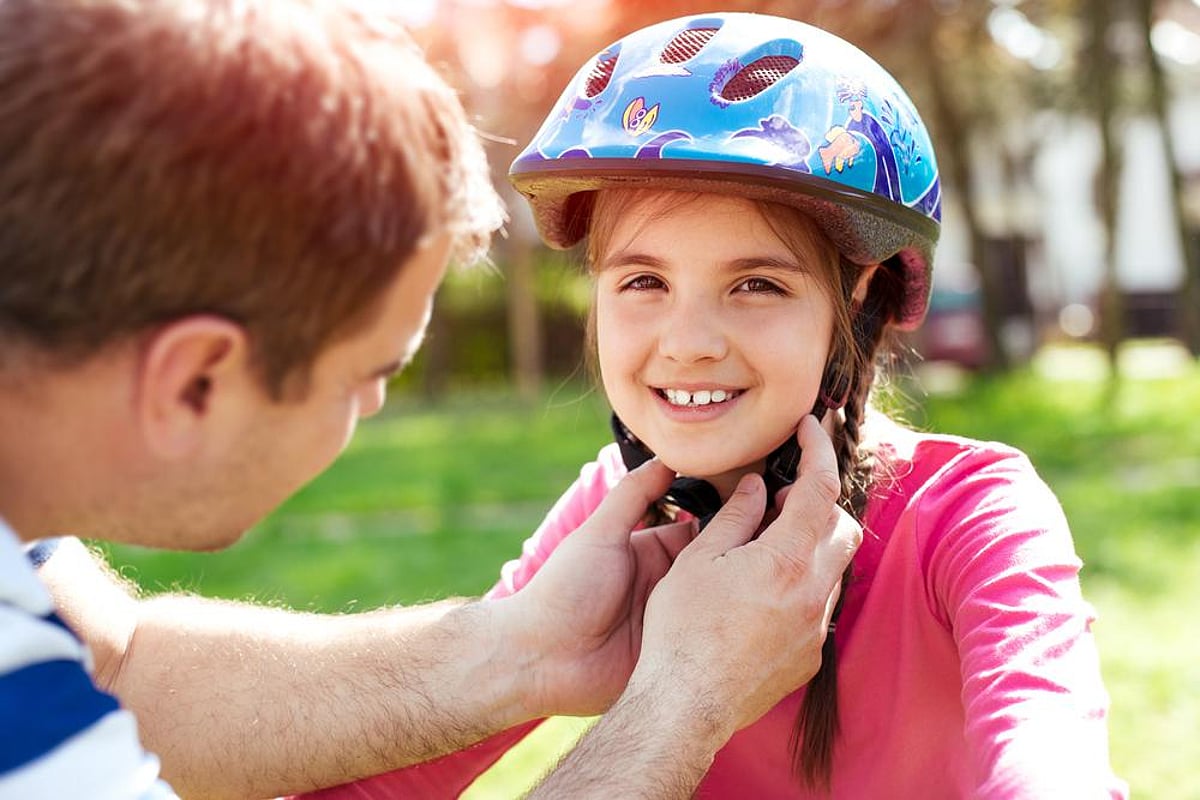Bicycle Helmets

Why should my child wear a bike helmet?
Every year about 25 children an hour are rushed to hospital emergency rooms with injuries from bicycle wrecks -- many of them head injuries that can cause brain damage and life-long disabilities. But these injuries are largely preventable if your child wears a bike helmet, which can reduce the risk by 85 percent, according to the U.S. Consumer Product Safety Commission (CPSC). That's why your child needs a helmet every time she gets on her bike or rides in a bicycle carrier -- and each time she skates, in-line skates, skateboards, or rides a tricycle or big wheel. Remember, even a bike with training wheels can tip over.
Bike helmets are becoming more popular, but they still have a long way to go. The Centers for Disease Control and Prevention reported only 15 percent of kids use a helmet most or all of the time when riding bikes. So if you think your child plays it safe, you'd better check again.
What kind of helmet should I buy?
Since February 1999, all bike helmets have to meet uniform safety standards issued by the CPSC, so the brand isn't as important as the fit and whether your child will wear the helmet. But this is one item you don't want to buy at a garage sale: a used helmet may have hidden weak spots from previous crashes. Besides, newer helmets are lighter, better-ventilated, and more comfortable than ever before, so your child has no excuse not to wear one.
No one type of helmet is right for every child. Toddlers usually need a toddler helmet, for example, which has a rounder shape to fit their heads. If you can find a new helmet that your child will actually wear, then you've made the right choice - as long as it's one that meets the standards set by organizations for bicycle safety.
Helmets also vary according to the sport; check with your local sports store for information about helmets for skating and skateboarding. Many health insurance plans also offer special discounts on children's helmets.
Should I replace my child's old helmet with a new one?
Not if her helmet meets one or more of the voluntary bicycle helmet standards set by organizations like ASTM, Snell, or ANSI. According to the CPSC, helmets that meet those standards provide enough protection for your child's head. Products approved by these associations have a logo on the box or on a small sticker inside the helmet. If the helmet has been in a crash, however, you should replace it.
How should my child wear her helmet?
First, be sure that she doesn't put the helmet on backwards, and that she buckles all the straps. The helmet should fit snugly, and often comes with extra foam, so you can customize the fit. Spend some time fixing a new helmet so it fits snugly -- and reevaluate it every year or so to see if you need to remove some of the foam pieces. You should be able to slide a finger under the chinstrap easily. Once you think the helmet is snug enough, push on the front. If you can push it off her forehead, then readjust the straps a little more snugly. The helmet should be flat on your child's head, not tilted back. If you can see her whole forehead, scoot the helmet forward.
How do I persuade my child to wear her helmet?
Make it a rule -- no helmet, no bike riding -- and stick to it. If your child wears a helmet from the time she's first in a bike carrier or on a big wheel or tricycle, she'll be more likely to wear a helmet all her life. (Never carry a child under age 1 on your bike, though, helmet or not.) And set a good example: If she sees you wearing a helmet each time you go riding, she'll be more likely to wear one, too.
If your child is used to riding bare-headed, or is embarrassed to use a helmet around her friends, you have a bigger challenge. Explain that a bicycle accident could cause permanent brain damage or even kill her. If she still balks, check with her school to find a helmet safety program where people with head injuries talk to kids about the importance of wearing a helmet. Also, let your youngster choose a "cool" helmet and decorate it with stickers.
Can helmets ever be dangerous?
Helmets can be lifesavers when a child is on a bike, but they aren't safe on the playground. Children have been strangled by the chinstraps when their bicycle helmets got stuck in play equipment. If your child likes riding her bike to the park, make sure her helmet comes off when her feet hit the ground.
Further Resources
Pantell, Robert H. M.D., James F. Fries M.D., and Donald M. Vickery M.D. Taking Care of Your Child: A Parent's Illustrated Guide to Complete Medical Care, Eighth Edition. Da Capo Lifelong Books.
References
U.S. Consumer Product Safety Commission. Bike Helmet Safety Alert. http://www.cpsc.gov/cpscpub/pubs/5002.html
U.S. Consumer Product Safety Commission. Parents to Keep Safety in Mind When Sending Children Back to School. http://www.cpsc.gov/cpscpub/prerel/prhtml06/06229....
Bicycle Helmets. Children's Safety Network. https://www.childrenssafetynetwork.org/sites/default/files/bicycle_helmets_childhood_injury_cost_prevention.pdf
Related Posts
2012 to 2021 Saw Drop in Bicycle-Related Injuries
WEDNESDAY, Dec. 21, 2022 (HealthDay News) -- The incidence of bicycle-related...
Immunity to Omicron Low for Children With Prior COVID-19 Infection
FRIDAY, June 3, 2022 (HealthDay News) -- For pediatric patients with prior...
Emergency Visits for Firearm Injuries Higher During Pandemic
THURSDAY, March 30, 2023 (HealthDay News) -- Emergency department visits for...
Una de cada tres sobrevivientes a un cáncer sufre un linfedema
JUEVES, 10 de marzo de 2022 (HealthDay News) -- Tras sobrevivir a un cáncer,...
